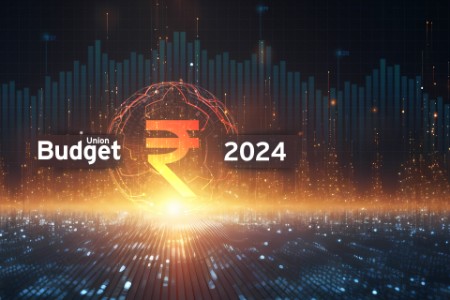Tarrung Kapur: A very warm welcome to the EY India Insights podcast. I am your host, Tarrung Kapur. In this episode of the Budget Insights series, we will analyze the Union Budget 24-25, released on 23 July 2024, and attempt to filter out key macro fiscal Insights with our guest today, Dr. D.K. Srivastava. Dr. Srivastava is a distinguished economist with more than 50 years of experience in the field of macroeconomics and public finance.
He is currently EY India's Chief Policy Advisor and also a member of the Advisory Council to the 16th Finance Commission. A very warm welcome to you, Dr. D.K. Srivastava.
Dr. D.K. Srivastava: Thank you. Tarrung
Tarrung Kapur: So, let us start with the first question. In your opinion, how does this budget differ from the interim one, and what are your key takeaways?
Dr. D.K. Srivastava: Well, the budget has accelerated the pace of fiscal consolidation by reducing the (target) fiscal deficit to GDP ratio to 4.9% as compared to the interim budget target of 5.1%.
On the revenue side, the budget assumes a nominal GDP growth of 10.5%, which is the same as in the Interim Budget and a Gross Tax Revenue (GTR) buoyancy of 1.03%. Together, this translates into a growth rate of 10.8% for gross tax revenues of the central government. Now, due to the marginally higher transfers to the states in terms of tax devolution, there is a slight fall in the Government of India’s net tax revenues when compared to the Interim Budget.
However, due to RBI’s increased dividends, total non-debt receipts are estimated to increase by a margin of INR1.27 lakh crore. This is the additional amount that is to be distributed in the budget. This was allocated largely between two heads, namely INR72,000 crore towards reduction in fiscal deficit and INR55,000 crore for increasing revenue expenditures.
This increase in revenue expenditure has been mainly devoted to labor and employment, housing, urban development, agriculture and renewable energy. Despite the increased allocation towards revenue expenditure, it is slated to grow only by 6.252%, which is only marginally than what was assumed in the Interim Budget. Capital expenditure growth remains the same at close to 17%. Thus, the Union Budget's clear emphasis is on fiscal consolidation while promoting growth and stimulating capital expenditure.
A large portion of nearly 70% of fiscal deficit is being devoted to capital expenditure in the budget.
Tarrung Kapur: Thank you very much, sir, for your Insights on the macroeconomic thrust of the Union Budget. Now, sir, my second question. How well do you think this budget incentivizes states to participate in India's growth story and how effective do you think these initiatives would be?
Dr. D.K. Srivastava: Well, the budget indicates several channels through which these state governments are being co-opted in the growth process. First, there is an increase in the provision of tax devolution to these states as compared to the Indian budget. The total amount of tax devolution to states is now estimated at INR12.47 lakh crore, implying an increase of INR27,428 crore. Second, these states have been given long-term interest-free loans to the tune of INR1.5 lakh crore in 2024-25 to augment their capital expenditures.
Further, there is a focus on the development of the eastern states as part of an initiative called ‘Purvodaya’. This, of course, includes Bihar and some of the northeastern states, in addition to Andhra Pradesh . Additional allocations thus are being made for various schemes to these states, including Bihar, Andhra Pradesh, Sikkim, Himachal Pradesh and Assam.
Some other proposed schemes in partnership with the states include development of industrial parks, development of cities as growth hubs and projects focusing on water supply, sewage treatment and solid waste management.
Tarrung Kapur: Thank you, sir, for these very useful perspectives. Now, in your view, is there any major point of concern with respect to the budget?
Dr. D.K. Srivastava: Well, I think that there is one major point of concern which relates to government's capacity, both at the central and state levels, to successfully and effectively undertake investment expenditures up to the extent of the budgeted amounts.
In the case of Government of India, there was an underspending compared to the budgeted amount both in 2022-23 and 2023-24. In 2023-24, out of the budgeted amount of INR10 lakh crore, only INR9.5 lakh crore could be utilized as per the Controller General of Accounts (CGA) actuals. Further, in 2024-25, while the budgeted capital expenditure is INR11.11 lakh crore, the total capital outlay is lower by INR20,000 crore as compared to the interim budget. In 2023-24 and 2024-25, the Government of India extended a long-term interest-free loan facility to the states amounting to INR1.3 lakh crore and INR1.5 lakh crore, respectively. The offtake of these amounts by the state was only partial in that year, and it is expected to be so in the present year if you go by the existing trends. In fact, they have time to spend it only in the post-monsoon months of the fiscal year.
Thus, there are indications that the investment led growth strategy appears to be moderating.
Tarrung Kapur: Thank you, sir, for your lucid and thoughtful Insights. Now, my final question is, given that the Government of India has been focusing on fiscal consolidation in recent years, by when can we expect it to reach the Fiscal Responsibility and Budget Management (FRBM) target of 3%?
Dr. D.K. Srivastava: Government of India’s fiscal deficit to GDP ratio had shot up to 9.2% in the COVID year of 2021. It was slowly brought down to 5.6% in the next three years, implying an annual average reduction rate of 1.2%. After this, the annual rate of reduction has been halved to 0.7%, with the Government of India’s fiscal deficit to GDP ratio budgeted to fall to 4.9% in 2024-25. If the annual rate of reduction (in the fiscal deficit to GDP ratio) is maintained, at least at about 0.6% on an average, we should be able to manage a reduction to a level of 3% of GDP by 2027-28, which would be consistent with FRBM targets.
Tarrung Kapur: Thank you very much. So, these are very extremely insightful perspectives. Thank you for joining us in this session and providing us your invaluable Insights.
Thank you to all our listeners and stay tuned for more captivating discussions on EY India Insights. And do not forget to subscribe for the latest updates. Until next time, this is the Tarrung Kapur for signing off.



